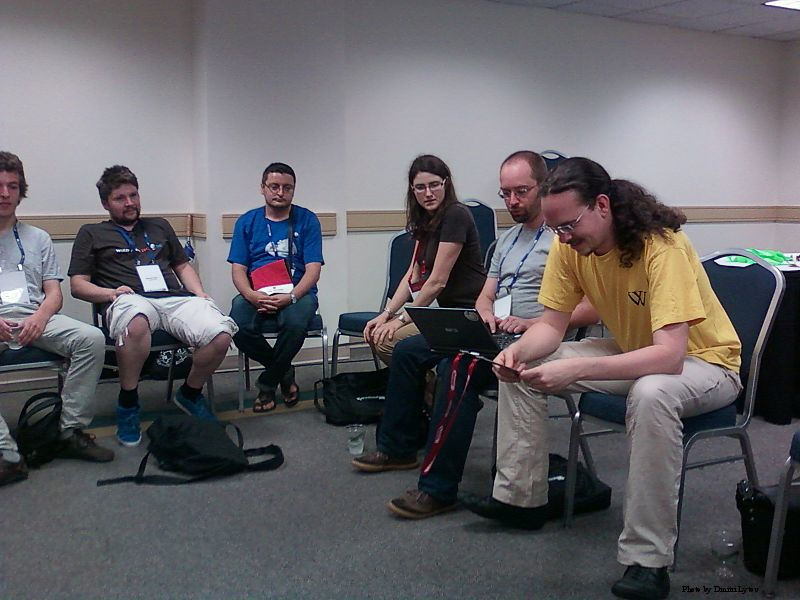by Stephen M. Klugewicz

Parlor at the McLean House, Appomattox Court House, Virginia, site of the surrender of Gen. Robert E. Lee at the end of the American Civil War.
On April 9, 1865, General Robert E. Lee met General Ulysses S. Grant at the McLean House in Appomattox, Virginia, for the purpose of surrendering the Army of Northern Virginia. Lee had asked for the meeting and had prepared by putting on his finest uniform: a new, long dress coat with a high collar buttoned to the top, a bejeweled long sword at his side, a pair of high-topped boots with spurs. Grant appeared in his typical attire, the simple uniform of a common soldier: a short coat and plain, spur-less boots, both much spattered with mud.
The contrast in attire matched the contrast in the men themselves: Lee was tall, straight in his bearing and solemn in his manner; the silvery-white hair and beard that ringed his visage befitted a king. The younger Grant was four inches shorter, somewhat stoop-shouldered, with a close-cropped brown beard. He was clearly ill at ease in the presence of Lee and nervously attempted some small talk. Grant offered that he still remembered Lee well from their one meeting during the Mexican War, almost two decades earlier. Lee confessed he could not recall anything about the occasion. Hearing Lee’s response must have been an awkward moment for Grant.

This image provided by the New-York Historical Society, shows Ulysses S. Grant, left, and Robert E. Lee at the end of the Civil War in an oil painting by Jean Leon Gerome Ferris titled “Let Us Have Peace, 1865.” Grant and Lee met face-to-face only twice, the second time being when Union commander Grant accepted the surrender of Lee’s battered Confederate army.
This climactic scene of the American Civil War has often been cited as emblematic of a watershed moment in history, the allegorical surrender of the Old World with its regal personalities, chivalric bonds, and inherited wealth to the New World embodied by Grant, a man of humble origins who had failed repeatedly in business and who finally made himself by making war (albeit with overwhelming advantages of men and materiel on his side). And it was indeed this.
But it was more. Less often noted is Grant’s careless disrespect to Lee in failing to dress properly for this meeting. Excuses have been made that Grant hurried to the meeting preoccupied with its impending business, that he was suffering from a days-long headache that morning and that consequently such “trivialities” as proper dress were the furthest thing from his mind. Grant’s admirers even point to his crude attire as a badge of honor: Here was the real rough-and-tumble American of the frontier, the true democrat, whose worth was to be found in his inner fortitude, his stick-to-it-tiveness, and not in the superficiality of his dress, the foppish concerns of an effete and decaying era.

Emily Post wrote, “Manner is personality, the outward manifestation of one’s innate character and attitude toward life.”
Wikimania Conference, which is a yearly meet-up of national and international people for Wikimedia’s projects.
But appearances do matter. As a student, the young George Washington once performed a copy exercise, titled “Rules of Civility & Decent Behaviour in Company and Conversation,” based on a 16th-century Jesuit text. At the top of this list of 110 rules was this guiding admonition: “Every Action done in Company, ought to be with Some Sign of Respect, to those that are Present.” This maxim had presided over Western culture since the Middle Ages, and it was exemplified in the courtly manners of the upper classes everywhere and at all times, from the knights of the Frankish kingdom to the nobles of the Elizabethan Age to the American Southern aristocratic class represented by Washington and Lee. Where the upper classes led, the lower classes followed. Manners trickled down, so that even the common laborer of nineteenth-century London attempted, when wearing his Sunday best, to emulate the attire of his betters. His top hat and waistcoat may have been worn and of inferior quality, but he wore them proudly nonetheless.

People venture out of their houses into public wearing their pajamas as they perform Saturday-morning errands.
Off to work. A man on a motorbike wearing pijamas in Nanjing, China.
Today the idea that the cultivation of manners should be an essential part of one’s education has been nearly lost entirely. It seems to have followed in death its greatest modern advocate, Emily Post. “Manner is personality,” Post wrote, “the outward manifestation of one’s innate character and attitude toward life.” Proof of the demise of manners is all around us: the open use of foul language on the public street, not simply by unkempt, uneducated youths but by middle-age, well-groomed businessmen; the in-your-ear blaring of something incorrectly deemed to be music by its devotees out car windows; the making of turns or changing of lanes by drivers without the courtesy of a turn signal; the routine violation of one’s personal space by passersby without the least expression of apology; and most obvious and appalling, the horrific decline in standards of dress everywhere. Indeed, T-shirts, jeans and sneakers have become standard attire for adults on “casual Friday” in the business world and, even more distressingly, at Sunday Mass. People venture out of their houses into public wearing their pajamas as they perform Saturday-morning errands. Today it is the lowest class of society that sets the standards of attire for everyone else; young people have adopted an exaggerated version of prison uniforms as their everyday attire, particularly excessively baggy pants, often worn so low that underpants and even one’s derriere is exposed for all to see.

Sporting instead tie-dyed shirts, ripped-up jeans, flip-flops and scraggly, unkempt hair upon the head and face, the Left taught, was the way to bring about the egalitarian revolution that would right society’s injustices.
The mannered society began its death throes in America in the 1960s. It was dealt its first lethal blow by the radical cultural and political Left, who preached that business suits, proper manners, and personal grooming were symbols of the oppression of the bourgeois middle class, of “The Man.” Sporting instead tie-dyed shirts, ripped-up jeans, flip-flops and scraggly, unkempt hair upon the head and face, the Left taught, was the way to bring about the egalitarian revolution that would right society’s injustices.
What was started by the Left of the political spectrum five decades ago was exacerbated by the Right years later. Largely in response to the chilling forms of what came to be called “political correctness” that were imposed by radicals on college campuses, right-wing libertarians beginning in the 1990s adopted the mantra that no one has a right not to be offended. In a decisive transformation of the old libertarian adage that one’s right to swing one’s fist stops only at someone else’s nose, these new libertarians claimed that their right to free speech was completely unrestricted by anyone’s religious sensibilities or sense of proper decorum. Thus pornography, outrageous satire of religious belief, and foul language were acceptable in the public square. If one was offended by such things, these libertarians preached, that was the problem of the offended person, not the offender. In effect, libertarians claimed that their right to spew forth whatever they wanted through the written and spoken word was not limited by another’s eye or ear. They said to the offended: Get over it!

In effect, libertarians claimed that their right to spew forth whatever they wanted through the written and spoken word was not limited by another’s eye or ear. They said to the offended: Get over it!
TFP Student Action campaigning in New York for Traditional Marriage, where a man ripped up their banner “One Man, One Woman”.
Thus the enemies of manners on both Left and Right together constituted modern-day Jacobins, determined not simply to bring down an unjust system of government but to obliterate the very fabric of society by destroying all standards of decorum. This parallel with the French Revolution brings us to the thinking of the great Anglo-Irish statesman Edmund Burke, who believed that the Jacobins of France were, above all else, launching an assault on “manners.” Now by “manners” Burke meant something broader than what we mean today, something akin to custom. To Burke, custom was nearly synonymous with civilization itself. “Manners are of more importance than laws,” Burke wrote. “Manners are what vex or soothe, corrupt or purify, exalt or debase, barbarize or refine us, by a constant, steady, uniform, insensible operation, like that of the air we breathe.”

If one was offended by such things, these libertarians preached, that was the problem of the offended person, not the offender.
Manners and civilization itself, Burke held, depended on two things: religion and “the spirit of gentleman.” Robert E. Lee believed this also. As president of Washington College in the years after Appomattox he had reduced the rules of the school to one sentence: “Every student must be gentleman.” To Lee and Burke, a gentleman was one who displayed Christian virtue as embodied in the medieval code of chivalry, an elaborate system of proper behavior towards others—manners in the narrower sense of the word.
The quality of Christian humility lay at the root of chivalry. A chivalrous knight (the term chivalry comes from the old French word, chevalier, meaning “horseman”) humbled himself to all others in society. Thus he was bound by duties not only to his lord, his superior, but to those weaker than himself, particularly women, whose innocent virtue he was tasked to protect, and the poor, whose pathetic condition he was obliged to alleviate. One thinks of St. Martin of Tours, who famously cut off half of his military cloak to provide a naked man with clothing. To adopt a philosophy of individualism in which one rejected concern for others would have been unimaginable to the Christian knight.

Museum Calouste Gulbenkian, Lisbon, Portugal. Saint Martin on horseback sharing his cloak with a beggar. France, Loire Valley, 1531. Limestone.
One must keep in mind how unique this Christian notion of humility, and its related idea of chivalry, have been in world history. In the ancient pagan world for example, humility was considered a sign of weakness. Too, in many non-Christian modern societies, superiors are expected to be rude to inferiors, a way of keeping everyone in his proper place in society. The mighty in most places and times have boldly asserted their power as a way to maintain the status quo.
But Christian chivalry, Burke believed, “made power gentle” and served to “beautify and soften private society.” It harmonized human relations. Without it, society could only be held together by brute force and cold reason. Gone would be the warmth of considerate human relations, corrupted would be the morals of men, and all would be reduced to slaves.

Manners and civilization itself, Burke held, depended on two things: religion and “the spirit of gentleman.” Robert E. Lee believed this also. As president of Washington College in the years after Appomattox he had reduced the rules of the school to one sentence: “Every student must be gentleman.”
A photograph of a priest about to say Mass for the Union soldiers during the American Civil War.
It is, of course, impossible to pinpoint the exact moment when the decline of chivalry and manners in the West began. Burke certainly saw the process well underway in Europe by the time of the French Revolution. “The age of chivalry is gone,” Burke wrote in his Reflections on the Revolution in France. “That of sophisters, economists, and calculators, has succeeded, and the glory of Europe is extinguished forever.” Perhaps in America the precipitous decline of manners began somewhat later, in a humble home in south-central Virginia, when the Last Cavalier of the Old World laid down his sword in defeat, giving way to the New World Order of centralized government, crony capitalism, and the narcissistic New Man, whose main concern was to be profit and personal happiness, not piety and humble concern for others.
Dr. Stephen M. Klugewicz is headmaster of Regina Luminis Academy, a private, Catholic, classical school in Downingtown, Pennsylvania. Dr. Klugewicz earned his B.A. in history at the College of William and Mary in Virginia, and his M.A. and Ph.D. in American history at the University of Alabama, Tuscaloosa. He has served as director of education at the National Constitution Center and at the Bill of Rights Institute and has also been the executive director of the Collegiate Network, the Robert and Marie Hansen Foundation, and Generation Life.
This article was originally published by Crisis on May 4, 2012 and is republished here with their kind permission.









